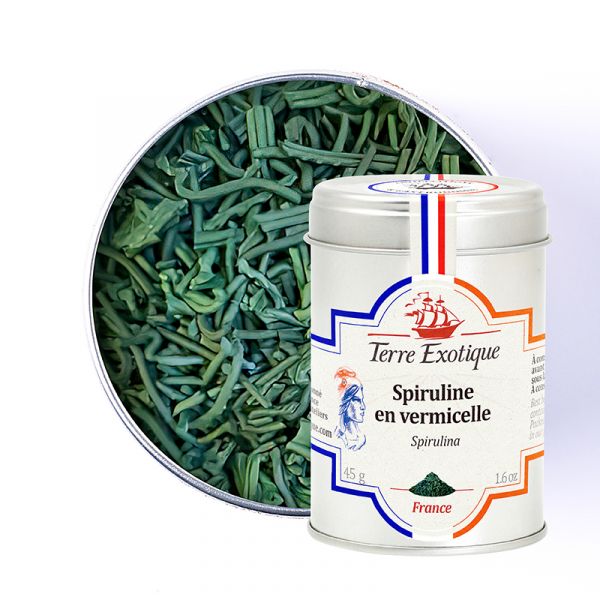



How is Spirulina grown?
A very surprising algae
Spirulina is a microalgae which dates back more than 3.5 billion years. Our Spirulina is produced in France by two spirulina enthusiasts from the Côtes d’Armor in Brittany, Hervé and Anne, who are committed to producing their Spirulina using environmentally sustainable and responsible methods. Spirulina is grown in closed circuit water ponds for ecological and sustainable purposes. The microalgae’s natural habitat needs to be perfectly reproduced for it to thrive, requiring very specific conditions. The water ponds must be salty and the pH must be between 9.5 and 10.5. It needs to be exposed to both light and shade but must also be protected by shade sails to avoid prolonged overexposure. All a very demanding process!Where to use this French Spirulina vermicelli
To ensure you get the very best from your Spirulina and take full advantage of all its health benefits, do not heat it to above 42°C and consume it gradually. Eat your spirulina preferably in the morning or towards midday and use a fuller teaspoon each day (starting with 1g for example and work up to a full 3g teaspoon) so that so your body can become accustomed to it.
Try out these recipe ideas:
• Spirulina guacamole: add ½ teaspoon of Spirulina to your ingredients then mash to create your guacamole;
• Green fruit smoothie: add 1 teaspoon of Spirulina to your smoothie then blend and enjoy;
• Green pancake: add 1 teaspoon of Spirulina to your pancake mixture;
• White chocolate and Spirulina cookies: add 1 teaspoon of Spirulina to your cookie dough.
Click to discover our Spirulina brownie recipe
What are the flavours of French Spirulina vermicelli?
The delicate taste of Spirulina releases slightly bitter notes of iodine and hints of matcha green tea. Spirulina is gently subtle and mild.
Discover other products from our French range:
- Turmeric flakes from Guadeloupe
Find out more about our French range
The history behind French Spirulina vermicelli
Spirulina was a daily part of the Aztec diet until the 16th century. They called it “Tecuitlatl” which means the “stone's excrement”. In his memoirs, Hernan Cortes, the Spanish conquistador, described how the Indians he met: “drew from lakes a sort of green mud that they dried in the sun and then ate as a type of tortilla”.
| Price/kg | 0 |
|---|---|
| Allergen | Absence |
| Native country | France |
| Genus and botanical species | Arthrospira platensis |
| Ingredients | spirulina |
| Nutritional Info | VN Energie pour 100 g (energy for 100g) : 1602 kJ / 383 kcal VN Matière grasse (fat) : 6.5 g Dont acide gras saturés (of which saturated fat) : 2.2 g VN Glucides (carbohydrate) : 15 g Dont sucres (of which sugars) : 1.1 g VN Protéines (protein) : 66 g Vn Sel (salt) : 2.5 g |
| Contenance | 45g |
| TRACES EVENTUELLES D'ALLERGÈNES | céleri, sésame, moutarde, fruits à coques. |
 Français
Français 